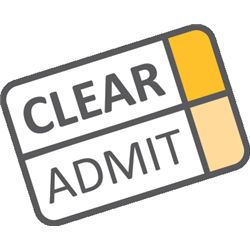 Of all the GMAT question types, Data Sufficiency is the most unique. Consequently, it tends to be the most feared. And as a result of that, most Data Sufficiency lessons focus more on how to “get through” Data Sufficiency than on how to conquer it. GMAT students are taught vanilla strategies to play Data Sufficiency safe, and then pat themselves on the back for learning techniques to essentially read the answer choices a second or two faster (let’s be honest, the famed AD/BCE and 1-2-T-E-N strategies are really just mnemonic devices to remember the answer choices that are always written on the screen for you).
Of all the GMAT question types, Data Sufficiency is the most unique. Consequently, it tends to be the most feared. And as a result of that, most Data Sufficiency lessons focus more on how to “get through” Data Sufficiency than on how to conquer it. GMAT students are taught vanilla strategies to play Data Sufficiency safe, and then pat themselves on the back for learning techniques to essentially read the answer choices a second or two faster (let’s be honest, the famed AD/BCE and 1-2-T-E-N strategies are really just mnemonic devices to remember the answer choices that are always written on the screen for you).
The following three strategies are not intended for those trying to creep their way up to a verbal-heavy 600 on the GMAT. And the following three strategies will contradict some of what you may have read on other blogs and forums. But for those who seek the highest quant scores and who are more concerned with conquering Data Sufficiency than with enduring it, what you are about to read will be instrumental in your GMAT quantitative success.
1. Use The Statements Together
Because of the answer choices “Statement (1) ALONE is sufficient…”; “Statement (2) ALONE is sufficient…”; “Both statements TOGETHER are sufficient but neither ALONE is sufficient…”, everyone is taught to never use the two statements together unless neither is sufficient alone. Which, again, isn’t so much a strategy as a re-reading of the answer choices. And it’s not terrible advice: if you’re not careful, it’s easy to carry over some of what you read in Statement 1 and therefore think that Statement 2 is more impactful than it really is. So you should be careful to consider each statement alone so that you don’t fall victim to that mistake.
That said, if you’re aiming for high quantitative scores, some statements are absolutely critical as clues telling you how to read the other statement alone. Consider the example:
Set J consists of the integers 2, 7, 12, 17, and x. Is x > 7?
(1) x is the median of Set J
(2) Set J does not have a mode
It is extremely common – and very understandable – for people to read statement 1 as saying 7 < x < 12, and therefore believe that it is sufficient to determine that, yes, x is greater than 7. And if you have those statement-by-statement blinders on, you’ll cross off B, C, and E and never return to statement 1 again. But when statement 2 turns out to be woefully insufficient, an astute examinee should see it as a clue: why would a mode matter? Well, the mode is the most frequently occurring value, and that very concept should get you thinking about repeat numbers. What if x were 7 itself? It would still be the median of the set 2, 7, x = 7, 12, and 17, but the answer to the question “is x > 7?” would be no. As it turns out, you do need statement 2 (making the correct answer C), but for most examinees it doesn’t occur to consider a repeat value until that word “mode” is staring you in the face.
For the truly elite scores, you either have to have incredible presence of mind or need to use the clues that the GMAT testmakers leave for you in “the other statement” from time to time. Dogmatically adhering to the principle “never consider the statements together until you know neither is sufficient alone” means that you’re leaving those clues unconsidered. Sometimes you have to consider the statements together to have a better understanding of each statement alone.
2. Do the math
Instructors often like to sugarcoat the downside of Data Sufficiency – it’s a new, tricky exercise for most examinees – with the notion that “because you only need to know whether you can solve the problem; you don’t need to actually finish the math!” And the students most likely to eat that up are the ones who can least afford to. If you’re so relieved that you can skip a few steps of algebra, you probably don’t have enough comfort with algebra to really trust your skills on challenging problems. Consider the example:
What is the value of x?
(1) x2 + 24x + 64 = 6x -17
(2) 6x – 17 = 37
Here many will quickly write off statement 1 as an ugly quadratic (quadratics give two solutions – why stress the math when you know where it will end up?) and then see that statement 2 is a linear equation that guarantees exactly one answer. But the true quant experts worry about making such a quick conclusion regarding statement 1, and will at least work the math into quadratic form for a peek before they go too far. Doing so, then, leads you to x2 + 18x + 81= 0, which factors to (x + 9)2 = 0. x must equal -9: statement 1 is actually sufficient, but it requires you to buckle down and do more math than you might want to.
When can you stop doing the math? Only when you are absolutely certain that completing it will give you a definitive answer. And, unfortunately, that level of certainty is much more likely to come to those who don’t mind the extra few steps of math, anyway. So yes you could stop a few steps early, but if you’re that concerned about doing those steps in the first place you have to know that you’re taking a risk. And if you’re comfortable enough that those steps are a matter of a few seconds, you’re probably testing well enough in the adaptive algorithm that you’ll face a question or two on which you’ll be glad you took the extra time.
3. Ask for forgiveness, not for permission.
When GMAT students pick numbers to test mathematical relationships, they often fall into the trap of picking “safe” numbers and then drawing incorrect conclusions based on them. Later on, they feel a bit cheated when they say “I didn’t realize I was supposed to think about fractions” or “how was I supposed to know to try numbers with that many digits?”. The key on Data Sufficiency is to realize that if you’re not told you can’t, you can. Consider the example:
Is positive integer x greater than 1?
(1) x is the product of integers j, k, m, and n
(2) j > k and m > n
Here there are plenty of reasons to think that the answer has to be “yes.” x is defined as positive, so 0 and negative numbers are out. And some combination of statements 1 and 2 have to demonstrate that j, k, m, and n are all different integers. Right? Not so fast: even given both statements together, why can’t j and m each be 1 and k and n each be -1? The problem doesn’t tell you that the variables can’t represent the same numbers, and since there isn’t a definition that the integers are “unique” or that j > m > k > n or some other designation that tells you that they’re all different, you can absolutely set some of the variables equal to each other. And in fact you have to; the answer is E precisely for that reason. The product could indeed by equal to 1 (“no”) even though most scenarios you can construct with those statements lead you to a number much greater than 1 (“yes”).
Strategically, that all means this: if the GMAT doesn’t tell you you can’t, assume that you can. Don’t look for permission to test crazy numbers or combinations; instead look for the boundaries and then push as close as you can to them. Data Sufficiency plays to the limits, so it’s no question type for those hoping to stay well between the lines. You have to be willing to rub the rails to test the whole scope os possibilities.
So remember, Data Sufficiency is indeed a unique and often-intimidating question type, but your goal shouldn’t be to play it safe and hope it goes away. To fight the biggest, baddest question type around you have to be willing to get a little dirty. These controversial strategies aren’t safe, but as you practice with them you’ll find that they’re certainly effective.
The above article comes from Veritas Prep. Since its founding in 2002, Veritas Prep has helped more than 100,000 students prepare for the GMAT and offers the most highly rated GMAT Prep course in the industry.
Special Offer: enroll in a Veritas GMAT prep course via the Clear Admit website and save $100!





